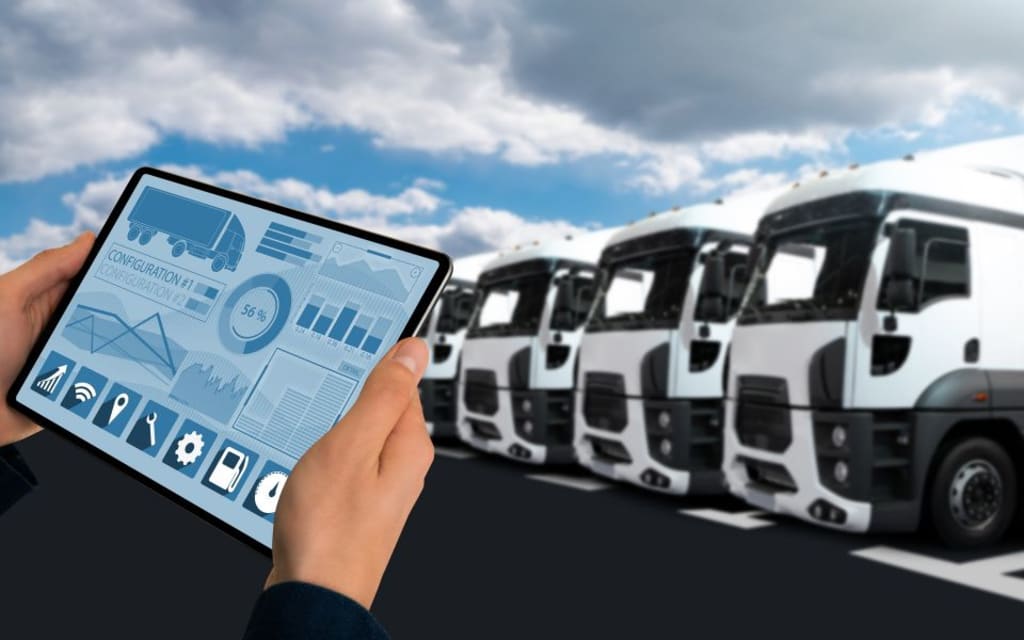How Does GPS Vehicle Tracking Fleet Management System Work?
This is the first step in the discussion. Let's take a look at what a GPS vehicle tracking fleet management system is, the advantages of a vehicle tracking system, and the features it offers.

GPS technology had a huge impact on the vehicle industry. Right now, it’s the GPS vehicle tracking fleet management systems that have taken this sector by storm. With GPS on the fleet, managers can now be relaxed about a lot of things.
Before heading on to the key discussion of this post, that is, taking a sneak peek into how a GPS vehicle fleet management system works, let’s have a look into the fundamentals.
What is a GPS Tracking Fleet Management System?
A GPS vehicle tracking fleet management system is a pragmatic solution that combines GPS technology with advanced software technologies to monitor and manage a fleet of vehicles efficiently. This system provides fleet managers with real-time visibility into the location, movement, and status of their vehicles.
Each vehicle is equipped with GPS tracking devices and by using those, the system gathers data on several parameters like vehicle speed, location, and mileage. The data is then transferred to a central server where it is processed and displayed on a user-friendly interface.
Fleet managers use the system to track the fleet's activities, optimize routes, monitor driver behavior, and allocate resources accordingly. A vehicle tracking system for fleet management also offers features like geofencing, automated alerts, and reporting tools that help in improving operational efficiency, and enable data-driven decision-making.
Advantages of a Vehicle Tracking System
The primary reason for the prolific use of a vehicle tracking system is the many benefits it bestows on organizations. Some of the most crucial ones include the following.
- Real-time Vehicle Tracking
GPS tracking gives fleet managers real-time visibility into the location of their vehicles. They can monitor almost every parameter including position, speed, and direction of every vehicle on a digital map.
- Improved Fleet Efficiency
The data gathered via the fleet management system offers valuable insights into vehicle usage, fuel consumption, and driver behavior. Fleet managers can use this data to identify inefficiencies like vehicle idle time, unauthorized vehicle use, or inefficient routing.
By addressing these issues on time, businesses can optimize their fleet operations, reduce fuel costs, and improve overall efficiency.
- Better Safety and Security
One of the core purposes of designing fleet management systems was to improve security and combat vehicle thefts. Features like geofencing and real-time alerts allow fleet managers to define virtual boundaries on the map. Whenever a vehicle enters or exits these boundaries, the system sends notifications.
This helps in the prevention of unauthorized vehicle use or theft. Also, the ability to monitor driver behavior like speeding or harsh braking promotes safer driving habits and reduces the risk of accidents.
- Maintenance and Asset Management
Fleet management systems are able to track vehicle maintenance schedules based on distance traveled or engine hours. This leads to proactive maintenance planning, which in turn reduces breakdowns and costly repairs.
Moreover, businesses can efficiently manage their vehicle assets by monitoring their utilization, learning about underutilized vehicles, and making informed decisions regarding fleet size and composition.
How Does a Vehicle Tracking Fleet Management System Work?
A fleet management system makes for one of the most viable vehicle tracking solutions. But it isn’t just the GPS that comes into play. A vehicle tracking system is the amalgamation of several tools and technologies. Let’s have a quick look at the core technologies that make it happen.
- GPS Tracking Device
Global Positioning System, popularly known as GPS, is the core technology of a fleet management system. Each vehicle is equipped with a GPS tracking device. The device consists of a GPS receiver that communicates with GPS satellites to fetch the vehicle's precise geographic coordinates.
- Data Transmission
The GPS tracking device embedded within the vehicle gathers basic data along with other information like vehicle location, speed, altitude, etc. The gathered data is then transmitted to a central server over cellular networks.
- Central Server
The fleet management system works with a central server that receives the data transmitted by GPS devices. The collected information is then analyzed and processed to provide real-time tracking and monitoring data in a comprehensible format.
- Mapping Software
The central servers of GPS tracking systems use mapping software to overlay the GPS data on digital maps. This allows proper visualization of the vehicle's location and movement in real time. The mapping software can show the vehicles' positions, routes, and other details such as speed and direction.
- User Interface
The user interface of a fleet management system like a mobile app, a special software, or a web-based app provides authorized users like fleet managers and vehicle owners with real-time visibility. The information viewed over this interface is the one that has been processed by the central server.
- Reporting
A vehicle tracking system often comes with cloud-based services. This means that the system stores and supplies historical data on the vehicles and their parameters.
The system often comes with reporting tools that can be used to generate reports on fuel consumption, mileage, routes, etc. These reports prove valuable during the optimization of fleet management and in making informed decisions.
Apart from the technologies and tools mentioned here, GPS tracking systems can seamlessly integrate with other software solutions to enhance their overall functionality. For instance, coupling a vehicle tracking system with dispatch systems makes for better route optimization.
Summing Up
A vehicle tracking system utilizes GPS technology in combination with other devices and tools like a central server, mapping software, and reporting tools to provide fleet managers with a wealth of information including vehicle location, engine management, and other basic parameters.
When coupled with an in-cab device, the system provides drivers access to operational reports, offering valuable insights into their vehicle’s health and efficiency. It also helps with monitoring driver behavior like harsh usage, driving hours, idling, and speeding.
Industries like transportation, construction, and delivery that rely heavily on fleet operations find vehicle tracking systems to be indispensable asset. These systems help organizations optimize and improve operations by reducing operational costs and increasing productivity.
About the Creator
kathleenbrown
Technology consultant in leading software development company committed to providing end-to-end IT services in Web, Mobile & Cloud.






Comments
There are no comments for this story
Be the first to respond and start the conversation.